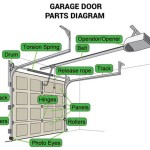How To Hang Tools in a Garage: A Comprehensive Guide
Organizing a garage often involves tackling the challenge of tool storage. Tools, by their nature, come in various shapes, sizes, and weights, making a one-size-fits-all storage solution virtually impossible. Effective tool storage not only creates a safer and more accessible workspace but also prolongs the lifespan of the tools themselves by protecting them from damage and corrosion. Hanging tools leverages vertical space, maximizing the usable area within the garage and keeping essential implements readily available.
Before embarking on any tool-hanging project, a thorough assessment of the garage space is crucial. This includes evaluating wall construction (drywall, wood studs, concrete), identifying weight-bearing limitations, and determining the frequency of use for each tool. A well-thought-out plan, considering these factors, will ensure a secure and functional storage system.
The initial step is a comprehensive inventory of all tools. This involves categorizing them based on size, weight, and function. Grouping similar tools together, such as gardening tools, automotive tools, or woodworking tools, streamlines the storage process. Furthermore, this inventory assists in determining the appropriate types of hanging systems needed.
Selecting the Right Hanging Systems
The market offers a diverse range of tool-hanging systems, each designed for specific purposes. Choosing the appropriate system for each tool is paramount for secure and efficient storage. Common options include pegboards, slatwall systems, magnetic tool holders, hooks, racks, and specialized brackets.
Pegboards: Pegboards are a versatile and relatively inexpensive option for storing a variety of hand tools. They consist of a perforated hardboard panel onto which various hooks, brackets, and containers can be attached. Pegboards are particularly well-suited for small to medium-sized tools, such as screwdrivers, wrenches, pliers, and hammers. The flexibility of rearranging the hooks allows for easy customization as tool collections evolve. When installing a pegboard, ensure it is securely mounted to wall studs using appropriate screws. Reinforcement may be necessary for heavier tools.
Slatwall Systems: Slatwall systems offer a more robust and aesthetically pleasing alternative to pegboards. These systems consist of horizontal panels with grooved channels, allowing for the attachment of specialized hooks, shelves, and baskets. Slatwall systems are capable of supporting heavier loads than pegboards and are more resistant to damage. They are ideal for storing larger hand tools, power tools, and even sporting equipment. Installation typically involves screwing the slatwall panels directly into the wall studs.
Magnetic Tool Holders: Magnetic tool holders provide a convenient and space-saving solution for storing metal tools. These holders feature a powerful magnet that securely grips tools, preventing them from falling. Magnetic tool holders are particularly useful for storing frequently used tools, such as wrenches, sockets, and screwdrivers. They can be mounted horizontally or vertically on walls, workbenches, or even toolboxes. Ensure the magnetic strip is strong enough to support the weight of the tools being stored.
Hooks: Individual hooks are a simple and cost-effective option for hanging larger or oddly shaped tools. Hooks come in various sizes and shapes, including J-hooks, S-hooks, and screw-in hooks. They are suitable for storing items such as shovels, rakes, axes, and extension cords. When selecting hooks, consider the weight and size of the tool being hung. For heavy tools, use heavy-duty hooks and ensure they are securely anchored to a wall stud or concrete wall.
Racks: Racks are designed to hold multiple tools of a similar type. Examples include screwdriver racks, wrench racks, and pliers racks. Racks help to keep tools organized and easily accessible. They can be mounted on walls, workbenches, or inside cabinets. Choose racks that are specifically designed for the type of tools being stored.
Specialized Brackets: Certain tools, such as ladders, bicycles, and power tools, may require specialized brackets for secure storage. These brackets are designed to accommodate the specific shape and weight of the tool. For example, ladder hooks are designed to support the weight of a ladder, while bicycle hooks are designed to hang a bicycle from the ceiling or wall. Always use brackets that are specifically designed for the tool being stored and ensure they are properly installed according to the manufacturer's instructions.
Preparing the Walls for Tool Hanging
The structural integrity of the wall is paramount for safely hanging tools. Different wall types require different anchoring methods. Identifying the wall type is the first critical step.
Drywall Walls: Drywall is a common wall material in garages, but it is not inherently strong enough to support heavy tools on its own. For drywall walls, locating and utilizing the wall studs is essential. Studs are vertical framing members that provide structural support to the wall. A stud finder can be used to locate these studs. Once located, screws or nails can be driven directly into the studs to provide a secure anchor point. When hanging heavier tools, consider using longer screws to penetrate deeper into the stud. If a stud is not available in the desired location, drywall anchors can be used to provide additional support. However, drywall anchors are generally not suitable for hanging very heavy tools.
Wood Stud Walls: Wood stud walls offer a more robust surface for hanging tools compared to drywall. Screws or nails can be driven directly into the wood studs to provide a secure anchor point. For heavier tools, use longer screws to penetrate deeper into the stud. Pre-drilling pilot holes can help prevent the wood from splitting when driving in screws.
Concrete Walls: Concrete walls are the strongest type of wall and can support the heaviest tools. However, hanging tools on concrete walls requires specialized hardware and techniques. Concrete screws or anchors are used to secure the hanging system to the concrete. A hammer drill is typically required to create pilot holes for the screws or anchors. When drilling into concrete, wear safety glasses to protect your eyes from debris. Ensure the concrete screws or anchors are properly sized for the weight of the tools being hung.
Before installing any hanging system, ensure the wall surface is clean and free of debris. Use a level to ensure the hanging system is installed straight and plumb. Pay close attention to the manufacturer's instructions for installation, as improper installation can compromise the integrity of the hanging system.
Optimizing Tool Placement and Accessibility
The arrangement of tools on the wall is just as important as the hanging system itself. Consider the frequency of use for each tool and its proximity to the workbench or work area. Tools that are used most often should be placed within easy reach, while less frequently used tools can be stored higher up or further away.
Organize tools by function or category. Grouping similar tools together, such as gardening tools or automotive tools, makes it easier to find the right tool when needed. Labeling the hanging system can also help to identify tools quickly. Consider using color-coded labels to further categorize tools. For example, red labels could be used for automotive tools, while green labels could be used for gardening tools.
Maintain adequate spacing between tools to prevent overcrowding and ensure easy access. Avoid hanging tools so close together that they are difficult to grab or remove. Leave enough space around each tool to allow for easy manipulation.
Consider the height of the hanging system. If multiple people will be using the tools, ensure the hanging system is at a comfortable height for everyone. Avoid placing the hanging system too high, as this can make it difficult to reach the tools. Conversely, avoid placing the hanging system too low, as this can create a tripping hazard.
Regularly inspect the hanging system for signs of wear and tear. Check for loose hooks, brackets, or screws. Tighten any loose hardware and replace any damaged components. Periodically clean the hanging system to remove dust and dirt. This will help to maintain the integrity of the hanging system and prolong its lifespan.
By carefully selecting the right hanging systems, preparing the walls properly, and optimizing tool placement, it is possible to create a functional and organized garage space that makes it easier to find and use tools. A well-organized garage not only improves efficiency but also creates a safer and more enjoyable working environment.

23 Tips Tricks Ideas For Organizing Your Garage Extra Space Storage

7 Garage Wall Storage Tricks To Eliminate Clutter

Diy 2x4s To Hang Your Tools Garage Organization Youtube

7 Garage Wall Storage Tricks To Eliminate Clutter

31 Garage Organization Ideas To Create A Hub For Storage And Workstation Activities

23 Tips Tricks Ideas For Organizing Your Garage Extra Space Storage

Garage Storage S Canadian Woodworking

15 Ideas To Organize Your Garage

How To Organize Tools On A Pegboard The Home

23 Tips Tricks Ideas For Organizing Your Garage Extra Space Storage








